2019高考英语作文题目预测及范文:毛笔书法
- 格式:docx
- 大小:11.73 KB
- 文档页数:2
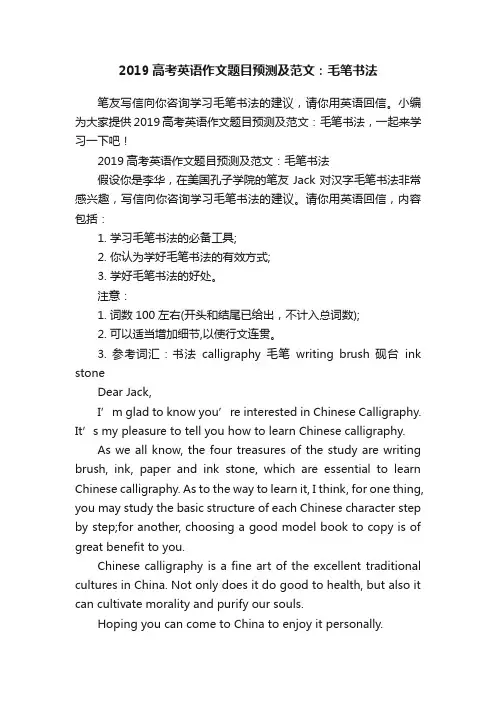
2019高考英语作文题目预测及范文:毛笔书法笔友写信向你咨询学习毛笔书法的建议,请你用英语回信。
小编为大家提供2019高考英语作文题目预测及范文:毛笔书法,一起来学习一下吧!2019高考英语作文题目预测及范文:毛笔书法假设你是李华,在美国孔子学院的笔友Jack对汉字毛笔书法非常感兴趣,写信向你咨询学习毛笔书法的建议。
请你用英语回信,内容包括:1. 学习毛笔书法的必备工具;2. 你认为学好毛笔书法的有效方式;3. 学好毛笔书法的好处。
注意:1. 词数100左右(开头和结尾已给出,不计入总词数);2. 可以适当增加细节,以使行文连贯。
3. 参考词汇:书法calligraphy 毛笔writing brush 砚台ink stoneDear Jack,I’m glad to know you’re interested in Chinese Calligraphy. It’s my pleasure to tell you how t o learn Chinese calligraphy.As we all know, the four treasures of the study are writing brush, ink, paper and ink stone, which are essential to learn Chinese calligraphy. As to the way to learn it, I think, for one thing, you may study the basic structure of each Chinese character step by step;for another, choosing a good model book to copy is of great benefit to you.Chinese calligraphy is a fine art of the excellent traditional cultures in China. Not only does it do good to health, but also it can cultivate morality and purify our souls.Hoping you can come to China to enjoy it personally.Yours, Li Hua。
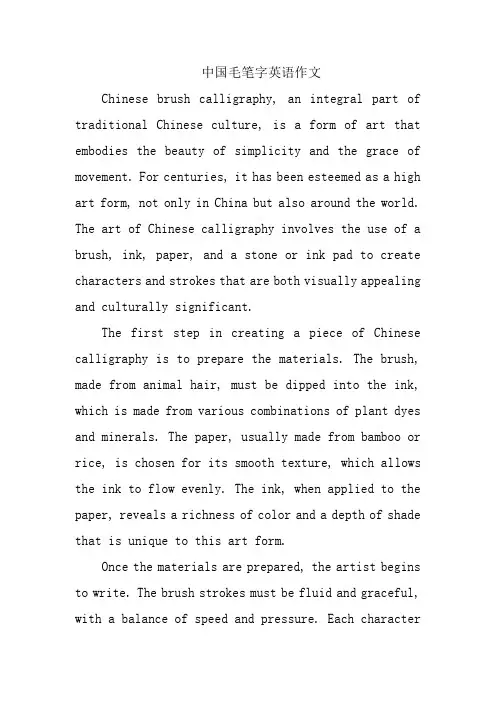
中国毛笔字英语作文Chinese brush calligraphy, an integral part of traditional Chinese culture, is a form of art that embodies the beauty of simplicity and the grace of movement. For centuries, it has been esteemed as a high art form, not only in China but also around the world. The art of Chinese calligraphy involves the use of a brush, ink, paper, and a stone or ink pad to create characters and strokes that are both visually appealing and culturally significant.The first step in creating a piece of Chinese calligraphy is to prepare the materials. The brush, made from animal hair, must be dipped into the ink, which is made from various combinations of plant dyes and minerals. The paper, usually made from bamboo or rice, is chosen for its smooth texture, which allows the ink to flow evenly. The ink, when applied to the paper, reveals a richness of color and a depth of shade that is unique to this art form.Once the materials are prepared, the artist begins to write. The brush strokes must be fluid and graceful, with a balance of speed and pressure. Each characteris composed of multiple strokes, each with its own specific direction and thickness. The artist must practice and cultivate a sense of rhythm and timing to achieve the desired effect. The finished piece is a testament to the artist's skill and the beauty of the Chinese language.Chinese calligraphy is not just a visual art; it is also a form of personal expression and a means of conveying emotions and thoughts. The strokes can be bold and assertive, or delicate and refined, depending on the artist's intention and mood. The characters can be arranged in various styles, such as horizontal, vertical, or circular, each with its own aesthetic appeal.In addition to its aesthetic value, Chinese calligraphy also holds deep cultural and historical significance. Each character represents not only a sound and a meaning but also a philosophy or concept. The art of Chinese calligraphy is a reflection of the Chinese people's appreciation for beauty, harmony, and the balance of life.In conclusion, Chinese brush calligraphy is acomplex and beautiful art form that requires skill, practice, and a deep appreciation of the Chinese language and culture. It is a testament to the enduring legacy of Chinese art and continues to be cherished and practiced by artists around the world.中文翻译:中国毛笔字是传统中国文化的重要组成部分,是一种体现简洁之美和运动之优雅的艺术形式。
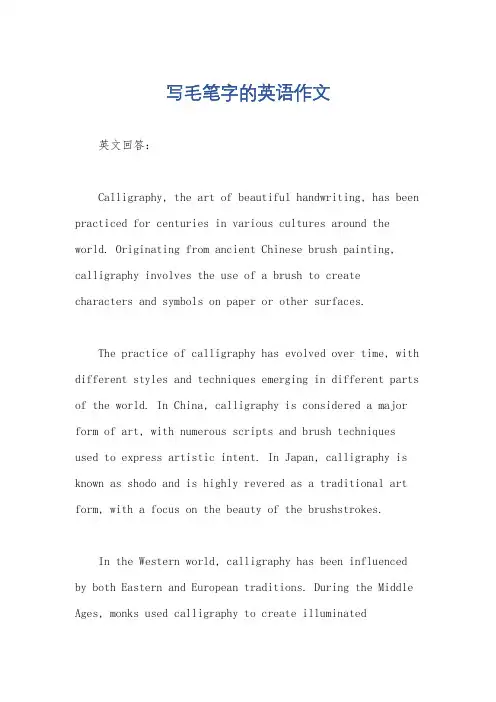
写毛笔字的英语作文英文回答:Calligraphy, the art of beautiful handwriting, has been practiced for centuries in various cultures around the world. Originating from ancient Chinese brush painting, calligraphy involves the use of a brush to create characters and symbols on paper or other surfaces.The practice of calligraphy has evolved over time, with different styles and techniques emerging in different parts of the world. In China, calligraphy is considered a major form of art, with numerous scripts and brush techniques used to express artistic intent. In Japan, calligraphy is known as shodo and is highly revered as a traditional art form, with a focus on the beauty of the brushstrokes.In the Western world, calligraphy has been influenced by both Eastern and European traditions. During the Middle Ages, monks used calligraphy to create illuminatedmanuscripts, adding intricate lettering to religious texts. In the Renaissance, calligraphy became a popular art form, with humanists rediscovering ancient scripts and developing new ones. Modern calligraphy continues to flourish, with artists and designers using it in a wide variety of applications, from fine art to graphic design.The tools and materials used in calligraphy vary depending on the tradition and style. In Chinese calligraphy, brushes made from animal hair or bamboo are used, along with ink sticks that are ground to create a fluid writing medium. In Western calligraphy, a variety of pens, nibs, and inks are used to achieve different effects. The surface on which the calligraphy is created can also vary, with paper, parchment, and even stone being used throughout history.Learning calligraphy requires patience, practice, and a keen eye for detail. Practitioners often begin by studying the basic strokes of a particular script. As they progress, they learn to combine these strokes into characters and symbols, paying close attention to the balance, proportion,and rhythm of the writing. Mastering calligraphy can take years of dedicated practice, but the rewards can be immense, both artistically and personally.中文回答:书法,一门以精美的笔迹见长的艺术,数百年来在世界各地的不同文化中流传。
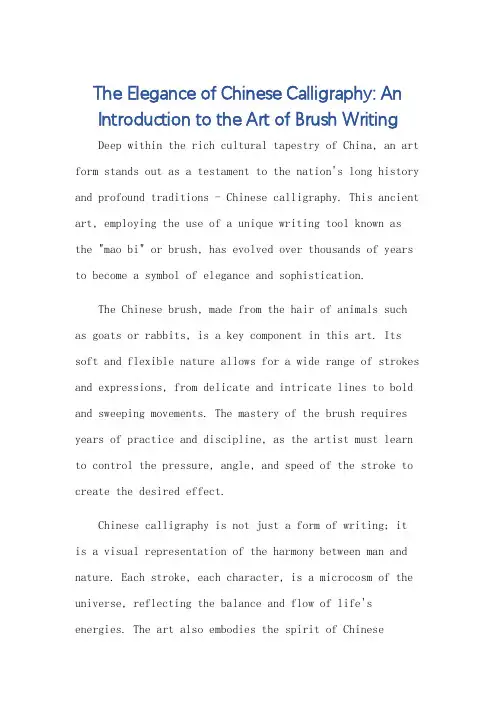
The Elegance of Chinese Calligraphy: AnIntroduction to the Art of Brush WritingDeep within the rich cultural tapestry of China, an art form stands out as a testament to the nation's long history and profound traditions - Chinese calligraphy. This ancient art, employing the use of a unique writing tool known as the "mao bi" or brush, has evolved over thousands of years to become a symbol of elegance and sophistication.The Chinese brush, made from the hair of animals such as goats or rabbits, is a key component in this art. Its soft and flexible nature allows for a wide range of strokes and expressions, from delicate and intricate lines to bold and sweeping movements. The mastery of the brush requires years of practice and discipline, as the artist must learn to control the pressure, angle, and speed of the stroke to create the desired effect.Chinese calligraphy is not just a form of writing; itis a visual representation of the harmony between man and nature. Each stroke, each character, is a microcosm of the universe, reflecting the balance and flow of life's energies. The art also embodies the spirit of Chinesephilosophy and ethics, with its emphasis on harmony, respect, and humility.Over the centuries, Chinese calligraphy has developed into various styles, each reflecting the characteristics of a particular era or individual artist. Styles range from the elegant and formal "shufa" to the freer and more expressive "caishu." These styles not only showcase the artist's skill but also reveal their personality and emotional state.In modern times, while the use of traditional writing methods has declined due to the widespread adoption of digital technology, Chinese calligraphy remains a vibrant and respected art form. It is still widely practiced and appreciated by many, not only as a means of artistic expression but also as a way to connect with the past and understand the depth and complexity of Chinese culture.Moreover, Chinese calligraphy has also gainedpopularity internationally, attracting art lovers and practitioners from all over the world. Its unique beauty and the challenge it poses to the artist have made it a fascinating and rewarding pursuit for many.In conclusion, Chinese calligraphy is a testament tothe rich cultural heritage of China. It is not only a formof artistic expression but also a vehicle for understanding the complexities and nuances of Chinese culture and philosophy. Its elegance and sophistication continue to inspire and captivate people from all walks of life, making it a timeless and enduring art form.**中国书法的优雅:毛笔书法艺术介绍**在中国丰富多彩的文化织锦中,有一种艺术形式以其深厚的历史传统和独特的魅力脱颖而出,那就是中国书法。
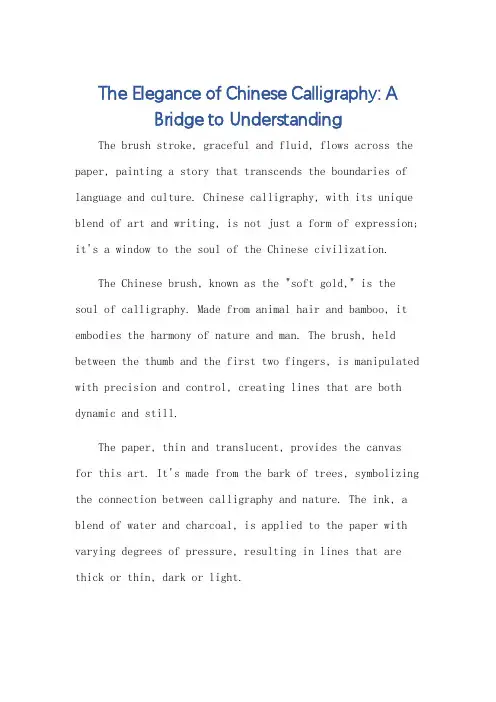
The Elegance of Chinese Calligraphy: ABridge to UnderstandingThe brush stroke, graceful and fluid, flows across the paper, painting a story that transcends the boundaries of language and culture. Chinese calligraphy, with its unique blend of art and writing, is not just a form of expression; it's a window to the soul of the Chinese civilization.The Chinese brush, known as the "soft gold," is the soul of calligraphy. Made from animal hair and bamboo, it embodies the harmony of nature and man. The brush, held between the thumb and the first two fingers, is manipulated with precision and control, creating lines that are both dynamic and still.The paper, thin and translucent, provides the canvasfor this art. It's made from the bark of trees, symbolizing the connection between calligraphy and nature. The ink, a blend of water and charcoal, is applied to the paper with varying degrees of pressure, resulting in lines that are thick or thin, dark or light.But it's not just the tools that make Chinese calligraphy unique; it's the scripts themselves. With over 5,000 years of history, Chinese characters have evolved from simple pictures to complex symbols that encode profound meanings. Each character is a story, a philosophy, a history lesson.Writing Chinese calligraphy is not just about following rules and structures; it's about understanding the spirit of the character. It requires patience, concentration, and a deep understanding of the culture and history behind it. It's a form of meditation, a way to connect with oneself and with the universe.The beauty of Chinese calligraphy lies in itssimplicity and complexity. The lines, though看似简单, are actually incredibly intricate, requiring years of practice and dedication to master. The art form is not just visual; it's also auditory, with the sound of the brush stroke on paper creating a rhythm that is both calming and inspiring. In today's digital world, where everything is fast and instant, Chinese calligraphy offers a slow and contemplative form of expression. It's a reminder that inthe midst of the hustle and bustle, there is still room for quiet reflection and beauty.Chinese calligraphy is not just a hobby or a skill;it's a way of life. It's a bridge between the past and the present, a connection to the ancestors and a legacy for the future. It's a universal language that transcends borders and brings people together through the shared experience of art and culture.As the brush strokes dance across the paper, they tell a story that is both ancient and timeless. They speak of a civilization that is both proud and humble, a culture that values harmony and balance. In the elegance of Chinese calligraphy, we find a reflection of ourselves and a connection to something much larger than ourselves.**中国书法的韵味:理解与沟通的桥梁**毛笔划过纸面的笔触,流畅而优雅,描绘出一段超越语言和文化界限的故事。
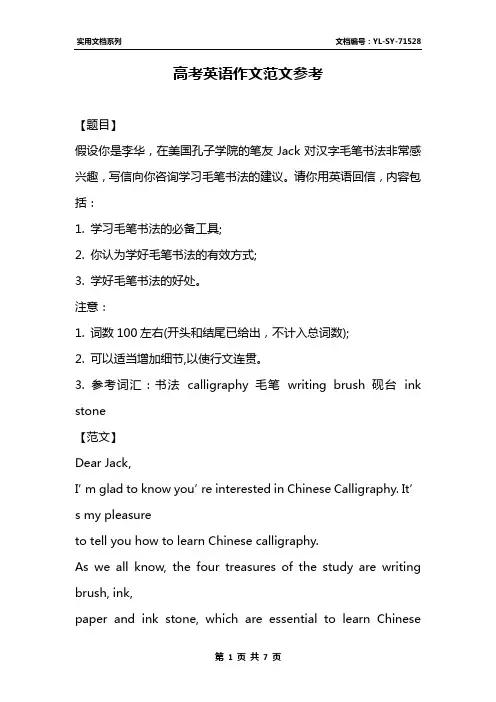
高考英语作文范文参考【题目】假设你是李华,在美国孔子学院的笔友Jack对汉字毛笔书法非常感兴趣,写信向你咨询学习毛笔书法的建议。
请你用英语回信,内容包括:1. 学习毛笔书法的必备工具;2. 你认为学好毛笔书法的有效方式;3. 学好毛笔书法的好处。
注意:1. 词数100左右(开头和结尾已给出,不计入总词数);2. 可以适当增加细节,以使行文连贯。
3. 参考词汇:书法calligraphy 毛笔writing brush 砚台ink stone【范文】Dear Jack,I’m glad to know you’re interested in Chinese Calligraphy. It’s my pleasureto tell you how to learn Chinese calligraphy.As we all know, the four treasures of the study are writing brush, ink,paper and ink stone, which are essential to learn Chinesecalligraphy. As to theway to learn it, I think, for one thing, you may study the basic structure ofeach Chinese charACTer step by step;for another, choosing a good model book tocopy is of GREat benefit to you.Chinese calligraphy is a fine art of the excellent traditional cultures inChina. Not only does it do good to health, but also it can cultivate moralityand purify our souls.Hoping you can come to China to enjoy it personally. Yours,高考英语作文(二)【题目】假如你是李华,你的英国网友Forbes打算抽空到中国学习太极(Tai Chi),他写信向你求助,请你根据下列要点给对方写一封回信:1.介绍学太极好处;2.负责联系学习地点和老师;注意:1.词数100左右。
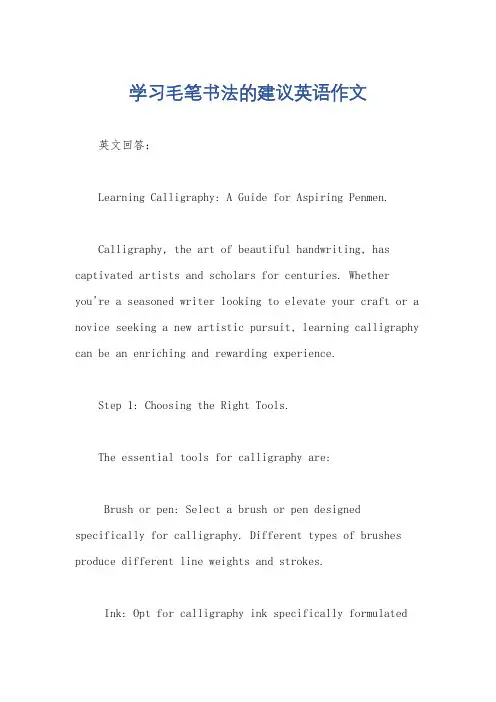
学习毛笔书法的建议英语作文英文回答:Learning Calligraphy: A Guide for Aspiring Penmen.Calligraphy, the art of beautiful handwriting, has captivated artists and scholars for centuries. Whetheryou're a seasoned writer looking to elevate your craft or a novice seeking a new artistic pursuit, learning calligraphy can be an enriching and rewarding experience.Step 1: Choosing the Right Tools.The essential tools for calligraphy are:Brush or pen: Select a brush or pen designed specifically for calligraphy. Different types of brushes produce different line weights and strokes.Ink: Opt for calligraphy ink specifically formulatedfor brush or pen use.Paper: Use smooth, high-quality paper that can withstand the brushstrokes without bleeding or feathering.Step 2: Mastering Basic Strokes.Before attempting full words or scripts, start by practicing basic strokes. These form the foundation for all calligraphy styles:Upstrokes: Hold the pen at a 45-degree angle and apply pressure as you move upwards.Downstrokes: Hold the pen perpendicular to the paper and release pressure as you move downwards.Curves: Control the pen speed and pressure to create smooth, graceful curves.Ovals: Combine upstrokes, downstrokes, and curves to form closed ovals.Step 3: Understanding Calligraphy Styles.There are numerous calligraphy styles, each with its unique characteristics:Modern calligraphy: A contemporary style characterized by fluid, expressive strokes.Gothic script: A medieval script with pointed letters and elaborate flourishes.Brush script: An East Asian style using a soft brush and black ink.Copperplate script: A formal and elegant script with fine hairlines and thick strokes.Step 4: Practice Regularly.As with any skill, practice is essential for improvement. Dedicate time each day to practice yourcalligraphy, focusing on consistent strokes and spacing. Experiment with different styles and techniques to discover what works best for you.Step 5: Seek Guidance and Critique.Find a calligraphy teacher or mentor who can guide you in your practice. Regular feedback and constructive criticism will help you identify areas for improvement and refine your skills.中文回答:学习毛笔书法建议。
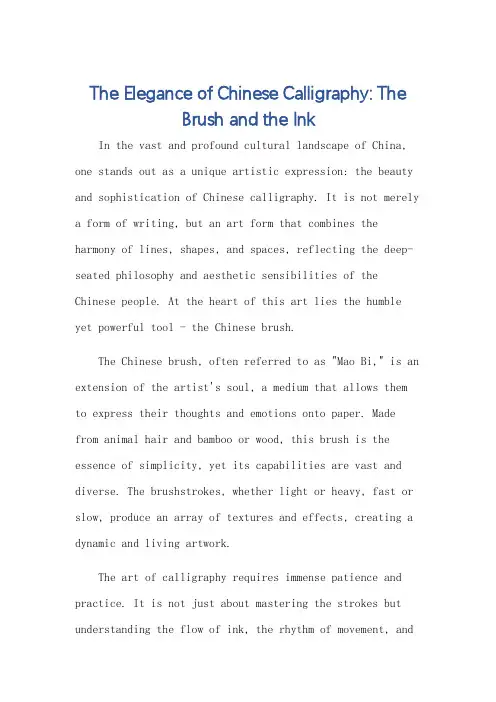
The Elegance of Chinese Calligraphy: TheBrush and the InkIn the vast and profound cultural landscape of China, one stands out as a unique artistic expression: the beauty and sophistication of Chinese calligraphy. It is not merely a form of writing, but an art form that combines the harmony of lines, shapes, and spaces, reflecting the deep-seated philosophy and aesthetic sensibilities of the Chinese people. At the heart of this art lies the humble yet powerful tool - the Chinese brush.The Chinese brush, often referred to as "Mao Bi," is an extension of the artist's soul, a medium that allows them to express their thoughts and emotions onto paper. Made from animal hair and bamboo or wood, this brush is the essence of simplicity, yet its capabilities are vast and diverse. The brushstrokes, whether light or heavy, fast or slow, produce an array of textures and effects, creating a dynamic and living artwork.The art of calligraphy requires immense patience and practice. It is not just about mastering the strokes but understanding the flow of ink, the rhythm of movement, andthe balance of pressure. Each stroke tells a story, eachink blotch a world of emotion. Chinese calligraphy is not bound by rigid rules; it thrives on spontaneity and creativity, making each piece unique and unrepeatable.The history of Chinese calligraphy dates back over3,000 years, evolving through various styles and periods. From the early scripts like Oracle Bone Script and Bronze Inscription Script to the more refined styles of seal script, clerical script, and running script, eachrepresents a chapter in Chinese history and culture. Calligraphy has been a part of daily life, used in letters, poetry, and even as a decorative art form.The influence of Chinese calligraphy extends beyond its artistic value. It has been a significant part of education, passed down from generation to generation as a way to cultivate patience, discipline, and creativity. Thepractice of calligraphy is also seen as a form of meditation, helping to calm the mind and connect with one's inner self.In today's digital world, where technology has revolutionized the way we communicate, the art of Chinesecalligraphy remains a timeless and relevant form of expression. It is a bridge between the ancient and the modern, connecting us to our cultural roots while also offering a unique aesthetic experience.The beauty of Chinese calligraphy lies not just in its visual elegance but also in the deep cultural significanceit carries. It is a testament to the rich history and profound wisdom of the Chinese people, a reminder of the power of art in transcending time and space. As we gazeupon a piece of calligraphy, we are not just admiring the beauty of lines and shapes; we are also embracing a pieceof ancient wisdom and cultural heritage.**中国书法的魅力:毛笔与墨汁**在中国博大精深的文化景观中,有一种独特的艺术形式脱颖而出:中国书法。
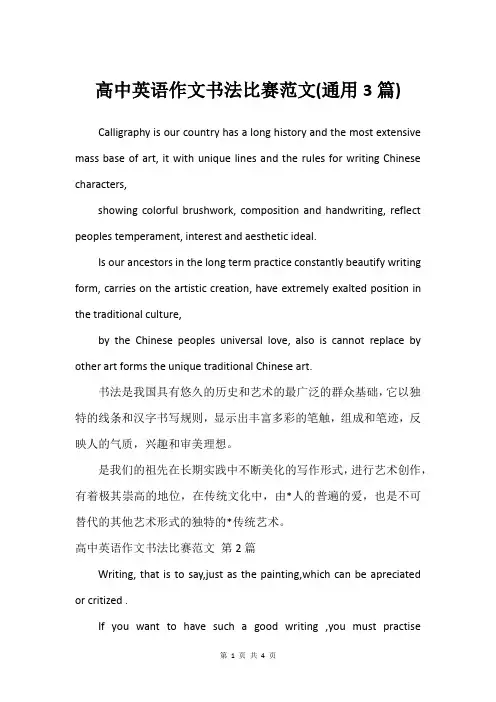
高中英语作文书法比赛范文(通用3篇)Calligraphy is our country has a long history and the most extensive mass base of art, it with unique lines and the rules for writing Chinese characters,showing colorful brushwork, composition and handwriting, reflect peoples temperament, interest and aesthetic ideal.Is our ancestors in the long term practice constantly beautify writing form, carries on the artistic creation, have extremely exalted position in the traditional culture,by the Chinese peoples universal love, also is cannot replace by other art forms the unique traditional Chinese art.书法是我国具有悠久的历史和艺术的最广泛的群众基础,它以独特的线条和汉字书写规则,显示出丰富多彩的笔触,组成和笔迹,反映人的气质,兴趣和审美理想。
是我们的祖先在长期实践中不断美化的写作形式,进行艺术创作,有着极其崇高的地位,在传统文化中,由*人的普遍的爱,也是不可替代的其他艺术形式的独特的*传统艺术。
高中英语作文书法比赛范文第2篇Writing, that is to say,just as the painting,which can be apreciated or critized .If you want to have such a good writing ,you must practiseeveryday,and you have better to immitate by the good writing ,which can improve your writing effectively.As for me,I think it is very important that you have some interest about it .This will make you train yourself willingly.As far as I am concered ,I like writing just as my teacher ,there was a time ,when I just a junior school stduent ,my teacher said ,good writing is helpful for us ,especially in the exam,the same question ,because of good writing ,which can get more.So ,when you start to improve it ,you shuoud have a goal or intest.*书法英语作文(菁华3篇)(扩展3)——*书法英语作文:Chinese Calligraphy (菁华3篇)高中英语作文书法比赛范文第3篇今天中午,天气非常好,学校准备举行“校毛笔十佳”的竞选。
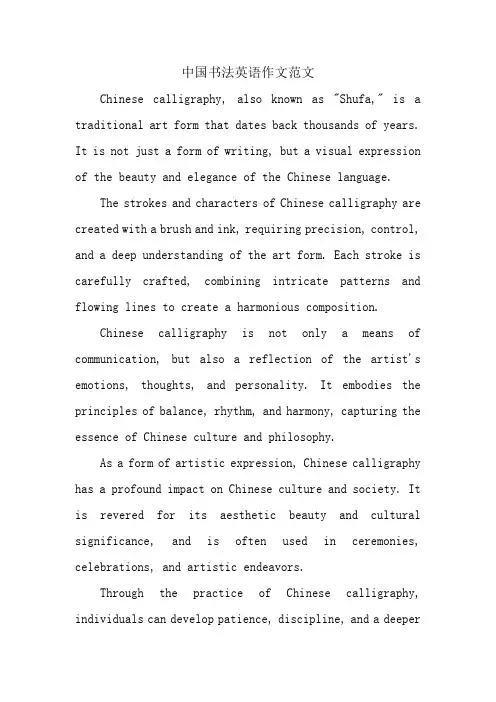
中国书法英语作文范文Chinese calligraphy, also known as "Shufa," is a traditional art form that dates back thousands of years. It is not just a form of writing, but a visual expression of the beauty and elegance of the Chinese language.The strokes and characters of Chinese calligraphy are created with a brush and ink, requiring precision, control, and a deep understanding of the art form. Each stroke is carefully crafted, combining intricate patterns and flowing lines to create a harmonious composition.Chinese calligraphy is not only a means of communication, but also a reflection of the artist's emotions, thoughts, and personality. It embodies the principles of balance, rhythm, and harmony, capturing the essence of Chinese culture and philosophy.As a form of artistic expression, Chinese calligraphy has a profound impact on Chinese culture and society. It is revered for its aesthetic beauty and cultural significance, and is often used in ceremonies, celebrations, and artistic endeavors.Through the practice of Chinese calligraphy, individuals can develop patience, discipline, and a deeperconnection to the art form and its historical roots. It is a meditative and contemplative practice that encourages self-expression and creativity.In a world of rapid technological advancements and globalization, Chinese calligraphy serves as a reminder of the importance of preserving traditional art forms and cultural heritage. It is a timeless art form that continues to inspire and captivate people around the world.中文翻译:中国书法,也被称为“书法”,是一种可以追溯数千年历史的传统艺术形式。
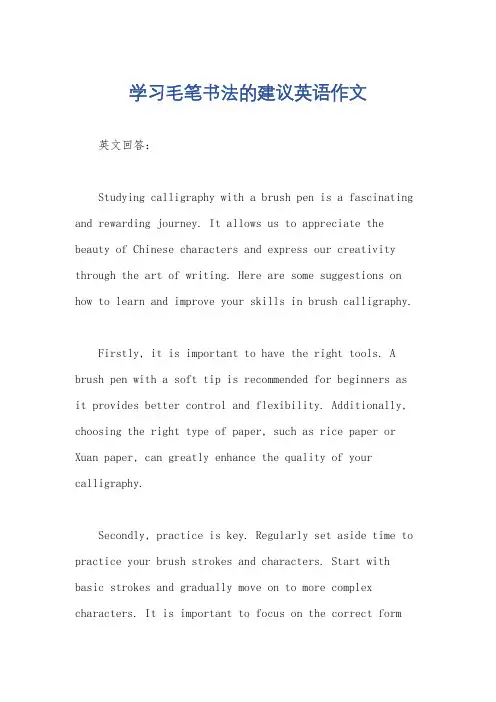
学习毛笔书法的建议英语作文英文回答:Studying calligraphy with a brush pen is a fascinating and rewarding journey. It allows us to appreciate the beauty of Chinese characters and express our creativity through the art of writing. Here are some suggestions on how to learn and improve your skills in brush calligraphy.Firstly, it is important to have the right tools. A brush pen with a soft tip is recommended for beginners as it provides better control and flexibility. Additionally, choosing the right type of paper, such as rice paper or Xuan paper, can greatly enhance the quality of your calligraphy.Secondly, practice is key. Regularly set aside time to practice your brush strokes and characters. Start with basic strokes and gradually move on to more complex characters. It is important to focus on the correct formand posture while writing. Remember, practice makes perfect.Thirdly, studying the works of renowned calligraphers can be highly beneficial. Analyze their techniques and styles, and try to incorporate them into your own writing. By studying different calligraphy styles, such as regular script, running script, and cursive script, you can broaden your understanding and improve your skills.In addition, attending calligraphy classes or workshops can provide valuable guidance and feedback. Learning from experienced calligraphers and interacting with fellow enthusiasts can greatly accelerate your progress. These classes often provide opportunities for hands-on practice and personalized instruction.Furthermore, finding inspiration from other art forms can help you develop your own unique style. Exploredifferent artistic mediums, such as painting or poetry, and incorporate elements of these into your calligraphy. This can add depth and creativity to your work.Lastly, do not be afraid to experiment and make mistakes. Calligraphy is a form of self-expression, and itis through trial and error that we discover our own individual style. Embrace imperfections and learn from them.中文回答:学习毛笔书法是一段迷人且有益的旅程。
关于学习毛笔字的英语作文Learning Chinese Calligraphy。
Chinese calligraphy, also known as "Shufa" in Chinese, is an ancient art form that has been practiced for thousands of years. It is a way of expressing oneself through the use of a brush, ink, and paper. The beauty of Chinese calligraphy lies in the combination of brushwork, ink, and paper. It is not only a form of art but also a way of cultivating one's character.Learning Chinese calligraphy is not an easy task. It requires patience, dedication, and practice. The first step in learning Chinese calligraphy is to choose a brush. The brush is the most important tool in calligraphy. It comesin different sizes and shapes, and each brush has its own unique characteristics. The next step is to choose theright ink. The ink should be of good quality and should not bleed or smudge. The paper used in calligraphy is also important. It should be of good quality and should be ableto absorb the ink well.Once you have the right tools, you can begin to learn the basic strokes of Chinese calligraphy. There are eight basic strokes: the horizontal stroke, the vertical stroke, the left-falling stroke, the right-falling stroke, the hook stroke, the dot stroke, the rising stroke, and the turning stroke. These strokes are the building blocks of Chinese calligraphy.After mastering the basic strokes, you can move on to practicing characters. Chinese characters are made up of strokes, and each stroke has a specific order and direction. It takes time and practice to learn how to write each character correctly. However, once you have mastered the characters, you can begin to create your own calligraphy.Chinese calligraphy is not just about writing characters. It is also about expressing oneself through the use of brushwork, ink, and paper. Each stroke should be made with care and intention. The beauty of Chinese calligraphy lies in the way the strokes are combined tocreate a work of art.In addition to being a form of art, Chinese calligraphy is also a way of cultivating one's character. It requires patience, dedication, and practice. It teaches us to be patient and to persevere in the face of difficulties. It also teaches us to appreciate the beauty of simplicity and to pay attention to the details.In conclusion, learning Chinese calligraphy is a rewarding experience. It is not only a way of expressing oneself but also a way of cultivating one's character. It requires patience, dedication, and practice, but the end result is a work of art that is both beautiful and meaningful.。
毛笔书法英文作文Title: The Elegance of Chinese Calligraphy: A Journey with the Brush。
Introduction:Chinese calligraphy, with its profound history and exquisite beauty, is a form of art that has captivated people worldwide. It embodies the essence of Chinese culture, reflecting the aesthetics, philosophy, and spirit of the Chinese people. In this essay, we will delve into the world of Chinese calligraphy, exploring its significance, techniques, and enduring appeal.Significance of Chinese Calligraphy:Chinese calligraphy holds a revered position in Chinese culture, often regarded as a visual art form that expresses the soul of the artist. It is not merely the act of writing but a harmonious blend of brushstrokes, ink, and paper,conveying emotions, thoughts, and aspirations. Through calligraphy, one can glimpse into the cultural heritage, values, and wisdom of the Chinese civilization.Techniques of Chinese Calligraphy:Mastering Chinese calligraphy requires years of dedicated practice and a deep understanding of its techniques. The brush, ink, paper, and inkstone are the essential tools of the calligrapher. Each brushstroke is meticulously executed, with varying pressure, speed, and angle, to create characters that resonate with grace and elegance. The five major styles of Chinese calligraphy –seal script, clerical script, regular script, running script, and cursive script – offer a spectrum of artistic expression, from structured precision to fluid spontaneity.The Artistry of Chinese Calligraphy:Chinese calligraphy transcends mere writing; it is a form of artistic expression that celebrates the beauty of simplicity and spontaneity. The rhythmic flow of strokes,the balance of space and form, and the dynamic interplay of black ink on white paper evoke a sense of harmony and tranquility. Each character becomes a work of art, imbued with the spirit of the calligrapher and the essence of Chinese culture.Enduring Appeal of Chinese Calligraphy:Despite the advent of modern technology, Chinese calligraphy continues to thrive as a cherished tradition and a source of inspiration for artists and enthusiasts alike. Its timeless beauty and cultural significance resonate across generations, transcending geographical and linguistic boundaries. From ancient scrolls to contemporary exhibitions, Chinese calligraphy continues to captivate audiences with its timeless elegance and profound depth.Conclusion:In conclusion, Chinese calligraphy stands as a testament to the rich cultural heritage and artistic legacy of the Chinese civilization. Its significance, techniques,and enduring appeal embody the essence of Chinese culture, serving as a bridge between the past and the present. As we embark on a journey with the brush, let us embrace the beauty and wisdom of Chinese calligraphy, cherishing it as a treasure of human creativity and expression.。
英语作文学习毛笔书法英文回答:Learning Chinese calligraphy with a brush can be a rewarding and fulfilling experience. It is an art form that has been practiced in China for centuries, and it is still widely practiced today. There are many benefits to learning calligraphy, including improved handwriting, increased focus and concentration, and a deeper appreciation for Chinese culture.If you are interested in learning calligraphy, there are a few things you will need to get started. First, you will need to purchase a brush, ink, and paper. You can find these supplies online or at a local art store. Once you have your supplies, you can begin practicing the basic strokes of calligraphy. There are many different strokes, and each one has its own unique form. It is important to practice these strokes regularly in order to improve your technique.Once you have mastered the basic strokes, you can begin practicing writing characters. There are thousands of different Chinese characters, so it is important to focus on learning the most common characters first. You can find a list of the most common characters online or in a calligraphy textbook.Learning calligraphy takes time and practice, but it is a rewarding experience. With patience and dedication, you can learn to write beautiful Chinese characters.中文回答:学习毛笔书法是一项很有意义的经历。
练毛笔字题材的英语作文Calligraphy: The Art of Written Expression.In the realm of artistic expression, calligraphy stands as an exquisite form that transcends mere writing. It elevates the act of penning words into an intricate dance, where strokes, characters, and space intertwine to create visual masterpieces. From the flowing grace of cursive scripts to the intricate beauty of Chinese ideograms, calligraphy captivates the senses and stirs the soul.In the East, calligraphy has flourished for centuries, deeply embedded in the cultural tapestry of nations like China and Japan. It is revered as an art form that embodies harmony, balance, and profound meaning. The characters themselves are not simply symbols representing sounds; they carry the weight of history, philosophy, and the essence of the written word.Chinese calligraphy, in particular, has reached anunparalleled level of artistic sophistication. With its thousands of ideograms, each with its own distinct shape and meaning, Chinese characters provide an infinitely rich canvas for calligraphic expression. The art of writing Chinese characters requires years of diligent practice, where the brush becomes an extension of the calligrapher's mind and spirit.Through dedicated practice, the calligrapher develops an intimate understanding of the flow of lines, the balance of strokes, and the subtle nuances of character formation. Each stroke is carefully calculated, each brushstroke imbued with intention. The result is a work of art that transcends the limitations of language, communicating emotions, ideas, and cultural heritage through the beauty of its form.In the West, calligraphy has also played a significant role in artistic expression, particularly in the context of religious texts. From the intricate manuscripts of medieval Europe to the elegant penmanship of Renaissance scribes, calligraphy added an element of beauty and reverence towritten works.Modern calligraphy has witnessed a resurgence of interest, with artists exploring innovative techniques and styles. From the bold, expressive brushstrokes of abstract calligraphy to the intricate precision of digital typography, contemporary calligraphers are pushing the boundaries of the art form.Calligraphy is not merely a technical skill but a profound form of artistic expression. It requires patience, dedication, and an intimate understanding of the medium. Through the act of calligraphy, practitioners seek to connect with the written word on a deeper level, imbuing it with beauty, meaning, and a touch of their own individuality.The practice of calligraphy offers numerous benefitsfor both the artist and the observer. For the artist, it fosters concentration, mindfulness, and a heightened awareness of the present moment. It cultivates an appreciation for the beauty of language and inspires asense of cultural connection.For the observer, calligraphy provides a unique aesthetic experience that transcends linguistic barriers. The visual beauty of the characters, the flow of the strokes, and the harmony of the composition evoke emotions and stimulate the imagination. Calligraphy has the power to transform ordinary words into works of art, offering a glimpse into the mind and soul of the artist.In conclusion, calligraphy is an art form that celebrates the written word and elevates the act of writing into a profound form of artistic expression. It is a testament to human creativity, the beauty of language, and the enduring power of tradition. Whether contemplating ancient Chinese scrolls or admiring contemporary abstract calligraphy, the art of calligraphy continues to captivate and inspire, reminding us of the transformative power of the written word.。
有关认为要练习考试的书法的英语作文The Importance of Practicing Calligraphy for Exam Preparation。
Calligraphy, the art of beautiful handwriting, has long been revered in many cultures around the world. In the context of exam preparation, the practice of calligraphy can be a powerful tool to enhance one's academic performance. As a student, the act of meticulously crafting each stroke and letter can not only improve your dexterity and attention to detail, but also cultivate a sense of discipline, focus, and mental clarity – all of which are essential qualities for success in any examination.One of the primary benefits of practicing calligraphy for exam preparation is the development of fine motor skills. The intricate movements required to create elegant calligraphic characters can help to strengthen the connection between the hand and the mind, improving hand-eye coordination and dexterity. This enhanced manual dexterity can translate directly to improved penmanship during exams, where neatness and legibility are often crucial factors in the assessment of written responses.Moreover, the practice of calligraphy encourages a level of focus and concentration that is highly beneficial for exam preparation. As you meticulously guide your pen across the page, carefully shaping each stroke, your mind becomes fully engaged in the task at hand, leaving little room for distractions or wandering thoughts. This heightened state of focus can be invaluable during the intense and often stressful environment of an examination, where the ability to maintain concentration and attention to detail can make all the difference.In addition to the practical benefits, the practice of calligraphy can also have a profound impact on one's mental well-being and emotional state. The meditative and rhythmic nature of the activity can induce a sense of calmness and relaxation, which can be particularly helpful in managing the anxiety and stress that often accompany the exam-taking experience. By engaging in calligraphy, students can find a respite from thepressure and tension of their studies, allowing them to approach their exams with a clearer and more focused mindset.Furthermore, the discipline and patience required in mastering the art of calligraphy can instill valuable character traits that are essential for academic success. The process of repeatedly practicing and refining one's calligraphic skills can foster a sense of perseverance, determination, and a willingness to embrace the challenges that come with learning and growth. These qualities can translate directly to the exam-taking process, where the ability to persist through difficulties and maintain a positive, proactive attitude can be the difference between success and failure.It is important to note that the benefits of practicing calligraphy for exam preparation extend beyond the immediate task of writing during the exam itself. The skills and mindset developed through this practice can have a lasting impact on a student's overall academic performance and personal development. By cultivating a deep appreciation for the art of calligraphy, students can develop a greater sense of attention to detail, a stronger work ethic, and a more disciplined approach to their studies – all of which can contribute to their long-term academic and personal growth.In conclusion, the practice of calligraphy can be a powerful tool for students preparing for exams. By enhancing fine motor skills, improving focus and concentration, promoting mental well-being, and instilling valuable character traits, the art of beautiful handwriting can be a transformative experience that can lead to academic success and personal growth. As students embark on their exam preparation journey, incorporating the practice of calligraphy into their routine can be a wise and rewarding investment in their future.。
写毛笔字的英语作文Ink brushes dance gracefully across the rice paper, each stroke a testament to the artist's skill and the beauty of calligraphy. Writing with a brush is not just a form of writing but an art form steeped in history and tradition, especially in cultures where the written word is revered as a form of visual art. The art of calligraphy, or "Shufa" in Chinese, is a practice that requires patience, discipline, and a deep appreciation for the fluidity of ink. It's an exercise in mindfulness, where the writer must be fully present to achieve the perfect balance between the brush and the paper.The tools of the trade are simple yet essential: a brush made from animal or synthetic fibers, ink made from soot and animal glue, and paper that is absorbent and smooth. The brush is held in a particular way, with the thumb and index finger forming a ring at the top, while the middle and ring fingers support the shaft. The movement is fluid, with the wrist doing most of the work, and the brush's tip leaving a trail of ink that can be thick or thin, depending on the pressure applied.To the untrained eye, writing with a brush might seemlike a simple task, but it's a delicate balance of force and finesse. Beginners often struggle with controlling the flow of ink and maintaining a steady hand, but with practice, the characters come to life with a unique personality thatreflects the writer's own. Each character in Chinese calligraphy has a specific structure and should be written in a particular order, which adds another layer of complexity to the art.The practice of writing with a brush is not just about creating beautiful characters; it's also a way to cultivate one's character. It's said that the character of the person can be seen in the character they write. This is why calligraphy is often used as a form of meditation, helping to calm the mind and focus the thoughts. It's a way to connect with the past, to appreciate the elegance of the written word, and to express oneself in a way that is both personal and profound.In the digital age, where typing on a keyboard has become the norm, the art of writing with a brush is a throwback to a time when communication was slower and more deliberate. It'sa reminder of the value of taking the time to createsomething by hand, of the joy that comes from the tactile experience of writing, and of the satisfaction that comesfrom seeing one's own words take shape on paper. Whether it's for personal enjoyment or as a form of cultural expression, writing with a brush is an art that continues to captivateand inspire.。
2019高考英语作文题目预测及范文:毛笔书
法
笔友写信向你咨询学习毛笔书法的建议,请你用英语回信。
为大家提供2019高考英语作文题目预测及范文:毛笔书法,一起来学习一下吧!
2019高考英语作文题目预测及范文:毛笔书法
假设你是李华,在美国孔子学院的笔友Jack对汉字毛笔书法非常感兴趣,写信向你咨询学习毛笔书法的建议。
请你用英语回信,内容包括:
1. 学习毛笔书法的必备工具;
2. 你认为学好毛笔书法的有效方式;
3. 学好毛笔书法的好处。
注意:
1. 词数100左右(开头和结尾已给出,不计入总词数);
2. 可以适当增加细节,以使行文连贯。
3. 参考词汇:书法 calligraphy 毛笔 writing brush 砚台ink stone
Dear Jack,
I’m glad to know you’re interested in Chinese Calligraphy. It’s my pleasure to tell you how to learn Chinese calligraphy.
As we all know, the four treasures of the study are
writing brush, ink, paper and ink stone, which are essential to learn Chinese calligraphy. As to the way to learn it, I think, for one thing, you may study the basic structure of each Chinese character step by step;for another, choosing a good model book to copy is of great benefit to you.
Chinese calligraphy is a fine art of the excellent traditional cultures in China. Not only does it do good to health, but also it can cultivate morality and purify our souls.
Hoping you can come to China to enjoy it personally.
Yours,
Li Hua。